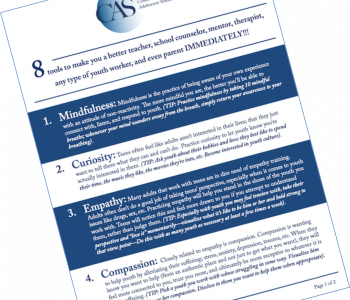

Catharine Hannay, MA
Catharine Hannay is the founder of MindfulTeachers.org and the author of Being You: A Girl’s Guide to Mindfulness, a workbook for teen girls on mindfulness, compassion, and self-acceptance.
Best Practices for Working with Trauma-Impacted Youth
Whether you work in counseling, social work, education, or health care, it’s likely you regularly encounter teens who’ve experienced trauma.
Here at the Center for Adolescent Studies, we have many resources to help you serve trauma-impacted youth, including information about:
- how trauma affects the brain;
- how to work with resistant youth;
- how to teach mindfulness effectively;
- how your own self-care practice can positively impact those you serve;
- and much more…
Introduction to Trauma
- A Brief History of Trauma for Youth Providers: From ‘Hysteria’ to PTSD, ACEs and intergenerational trauma.
- The Four Essentials of Being a Trauma-Informed Youth Professional: How trauma affects the brain and behavior, and the importance of relationship-building and self-care
- How Our Own ACEs Impact Trauma Work with Youth: Advice on coping with triggers and deciding how much to share about your own experiences.
- 4 ‘Must-Read’ Books for Professionals Working with Traumatized Youth: The Boy Who Was Raised as a Dog, The Body Keeps the Score, Supporting and Educating Traumatized Students, and Teens Who Hurt.
- Three Ways Traumatic Events in the Lives of Teens Impact Substance Abuse: It’s common for teens who’ve experienced trauma to self-medicate; this can lead to further problems.
- Trauma and the Brain: An Introduction for professionals working with teens: An overview of the major structures of the brain involved in processing trauma.
Trauma-Informed Care
- Add a Culturally-Aware Lens to Your Trauma-Informed Toolkit: There are multiple factors to consider when working with youth whose background is different from yours.
- Compassion Can Help You Work with Trauma-Impacted Youth: Two practices for intentionally building compassion for the youth in your care.
- Creating Safety with Group Agreements: Establishing and reinforcing a set of norms can help youth feel more comfortable with and supportive of their peers.
- Creating a Welcoming, Trauma-Informed Classroom Space: Seemingly small decisions can make a huge difference in providing a safe, supportive classroom space.
- A Critical Intervention for Working with Traumatized Youth: An INCRA, Inherently Non-Clinical Relational Activity, can help bring youth back into the window of tolerance so they can be receptive to other interventions.
- Guidelines for Teaching Trauma-Informed Mindfulness to Teens: Nine guidelines for safely and effectively sharing mindfulness with youth who’ve been impacted by trauma.
- How Can I Better Support Immigrant and Refugee Youth? It’s essential to understand the ways they may been impacted by trauma, as well as the complexities of adjusting to a new society.
- 3 Reasons Authenticity is a Trauma-Informed Practice: It’s important to build trust and predictability, and to model positive relationships.
- 3 Ways Compassion Can Help Youth Impacted by Trauma: Treating youth with compassion doesn’t mean letting them off the hook. It means recognizing their humanity and suffering, as well as their potential for positive change.
- 3 Ways Movement Can Help Trauma-Impacted Youth: Physical movement can be a powerful way to help youth focus on the present moment and understand how to self-regulate when they experience intense emotions.
- Tips for Working with Resistant Teens: A skillful approach to resistance helps teens become more self-aware, and also helps you prevent burnout.
- Using Mindfulness in Substance Abuse Treatment with Adolescents: Three guidelines for effectively incorporating mindfulness into youth substance abuse treatment programs.
- Working with Resistance and Traumatic Adaptations: Self-protective behaviors and reactions are often misperceived as deliberately rebellious or disruptive.
- Working with Youth with Intellectual and Developmental Disabilities (IDD) and Trauma: Kids with IDD are at increased risk for abuse and neglect, and they may have trouble communicating about what’s happening.
Self-Care for Youth Workers
- How Can I Focus on Self-Care When There’s Endless Need? If you never focus on your own mental and physical well-being, you’ll very quickly burn out and won’t be able to help the youth under your care.
- How Can I Help Others When I’m Struggling Myself? Eight ways to ‘refill your oxygen tank’ so you can keep serving others in a sustainable way.
- Vicarious Trauma: How Youth Workers Can Support Each Other Fair warning, consent, and limited disclosure will ease your own burden without hurting your coworkers.
- Self-care is self-love: The most critical skill in the direct service industry: Self-care includes intentional practices that promote your own mental, emotional, physical, and spiritual well-being.
- 3 Tips for Managing Compassion Fatigue and Empathic Distress: How to become more conscious of your limits and more aware of how to balance your own needs with the needs of those you serve.
- 6 Tips for Practicing Self-Care (Even When You Have No Time for Yourself): A few tips to help you figure out what you can control, so you can free up time and energy to focus on your own needs.
- 5 Tips for Recovering from Burnout and Reconnecting with Your Calling: Focus on what brings you joy, set reasonable limits, redefine success, look for unconventional signs of appreciation, and separate your job from your calling.
Join the FREE Resilience Community for Helping Professionals to learn more about trauma-informed care, resilience, mindfulness, building relationships, and more! Our community features self-paced courses, a monthly live Zoom call, a weekly live meditation, and an online platform to connect with other providers/professionals in your field.

